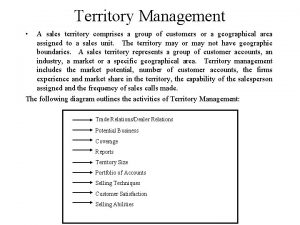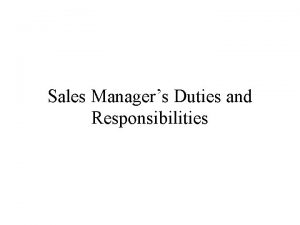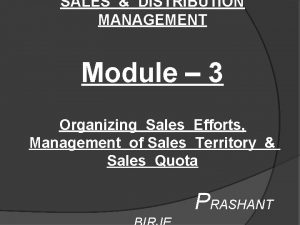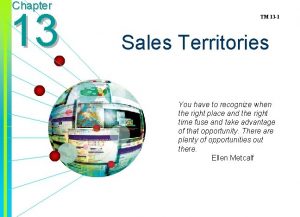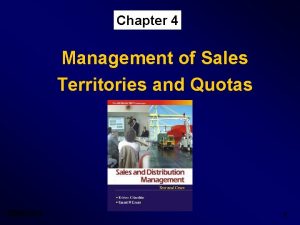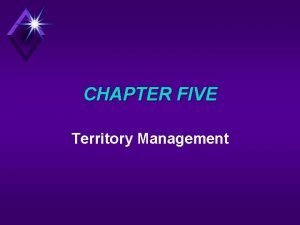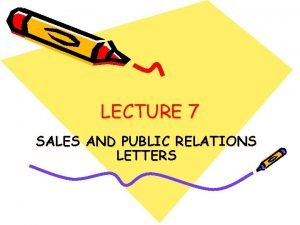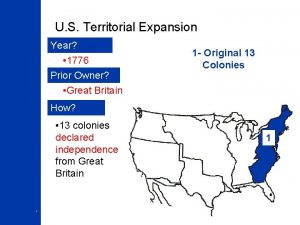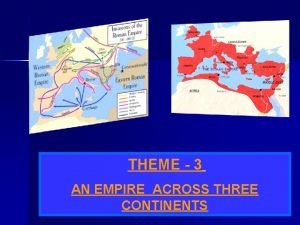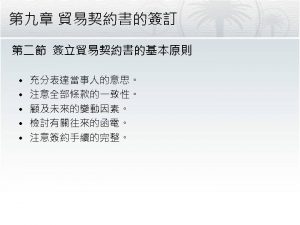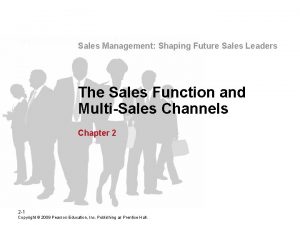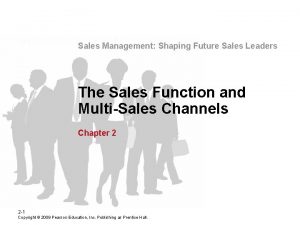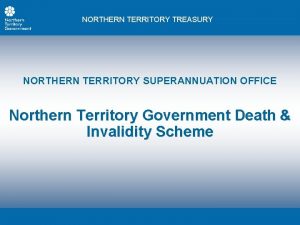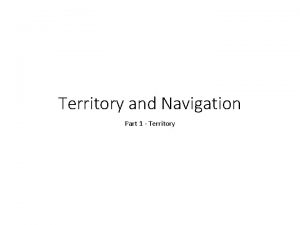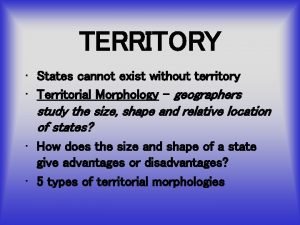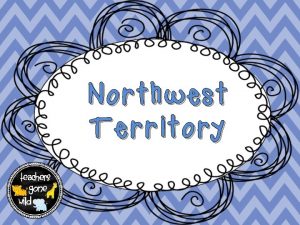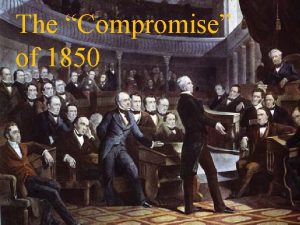TIME TERRITOR MANAGEMENT UNIT7 WHAT IS SALES TERRITORY


















- Slides: 18

TIME & TERRITOR MANAGEMENT UNIT-7

WHAT IS SALES TERRITORY? A sales territory consists of existing and potential customers, assigned to a salesperson. Most companies allot salespeople to geographic territories, consisting of current & prospective customers.

REASON FOR SETTING OR REVIEWING SALES TERRITORIES Increase market or customer coverage. Control selling expenses Better evaluation of sales force performance Improve customer relations Increase sales force effectiveness Improve co-ordination Benefit salespeople and company

REASON FOR NOT SETTING-UP SALES TESmall. RRc. Iomp Tany OR wti. Ih. E oe n. S or few salesperson(s). Personal contacts or relationships is the basis of making the sales. Sales persons get demotivated due to restrictions of sales territory. Management of the company may not be aware.

PROCEDURE FOR DESIGNING SALES TERRITORIES Select a control unit Find location and potential customer Use build method Decide basic territories OR Use breakdown method

CONTROL UNIT States Metros Cities Districts Towns Pin Code Areas Industrial Estates Major Customers Why sales manager should select smallest control unit? The control units’ market potential and the company sales potential should be possible to calculate. Addition and deletion of control units should be possible tentative when territory boundaries are modified to make final territories.

FIND LOCATION AND POTENTIAL CUSTOMER Identification of the buyers as precisely as possible. Present & potential buyers indicate Market Potential. Determination of Sales Potential i. e. unit’s market potential that the company has an opportunity to obtain. Market potential is converted to sales potential by analyzing the historical market share , adjusting for changes in company & competitor selling strategies.

DECIDE BASIC TERRITORIES Build-up Method – The objective is to equalise the work load of sales person. Breakdown Method – The objective is to equalise sales potential of territories.

Procedures followed in Build-up Method: Step 1 Decide call frequencies Step 2 Calculate total number of calls in each control unit Step 3 Estimate workload capacity of a Salesperson Step 4 Make tentative territories Step 5 Develop final territories Procedures followed in Breakdown Method: Step 1 Estimate company sales potential for total market Step 2 Forecast sales potential for each control unit Step 3 Estimate sales volume expected from each salesperson Step 4 Make tentative sales territories Step 5 Develop final territories

ASSIGNING SALESPEOPLE TO TERRITORIES The sales manager should consider two criteria: (A) Relative ability of salespeople Based on key evaluation factors: (1) Product knowledge (2) market knowledge (4) communication (5) selling skills (3) past sales performance (B) Salesperson’s Effectiveness in a Territory Decided by comparing social, cultural, and physical characteristics of the salesperson with those of the territory.

MANAGING TERRITORY COVERAGE It means “How salesperson should cover the assigned sales territory”. It includes three tasks for a sales manager: • Planning efficient routes for salespeople. (Routing) • Scheduling salespeople’s time. (Scheduling) • Using time-management tools. (Time Management)

ROUTING Routing is a travel plan or pattern used by a salesperson for making customer calls in a territory. The main advantage of routing are: a) Reduction in travel time and cost b) Improvement in territory coverage

Procedures for setting up a routing plan: Identify current and prospective customers on a territory map Classify each customer into high, medium, or low sales potential Decide call frequency for each class of customers Build route plan around locations of high potential customers Computerized mathematical models are developed as follows:

Commonly used routing patterns are: Cloverleaf Pattern c c c Base c c c c c Each Leaf Out and Back Same Day c c

Application and Importance of Routing: The degree of importance to the application of routing depends on two factors: a) Nature of the product b) The type of job of salespeople

SCHEDULING Scheduling is planning a salesperson’s specific time of visits to customers. It deals with time allocation problem. How to allocate salesperson’s time? • Sales manager communicates to salesperson major activities and time allocation for each activity • Salesperson records actual time spent on various activities for 2 weeks • Sales manager and salesperson discuss and decide how to increase time.

TIME MANAGEMENT TOOLS It help salespeople to manage their time more efficiently and productively. Tools available are: High-tech Equipment Inside Salespeople a) Sales assistance to provide clerical support for the outside salespersons. b) Technical support people to give technical information and answers to customer’s questions. c) Telemarketing to find new leads or prospects, qualify them and refer them to outside sales persons for high and medium sales potential prospects or sell for low potential customers.

 Sales territory management best practices
Sales territory management best practices A sales territory comprises
A sales territory comprises Sales manager duties and responsibilities
Sales manager duties and responsibilities Function of sales executive
Function of sales executive Sales territory design methods
Sales territory design methods Establishing sales territories
Establishing sales territories Territory management model
Territory management model Sales force structure example
Sales force structure example Difference between sales letter and sales promotion letter
Difference between sales letter and sales promotion letter Sales potential vs sales forecast
Sales potential vs sales forecast Sales force structure
Sales force structure Personal selling and sales management
Personal selling and sales management What is elapsed time
What is elapsed time What is a territory
What is a territory Greek and roman geography
Greek and roman geography Ohio valley territory
Ohio valley territory Prior owner of florida cession
Prior owner of florida cession Rome controlled territory on what three continents
Rome controlled territory on what three continents Who lost territory after ww1
Who lost territory after ww1

